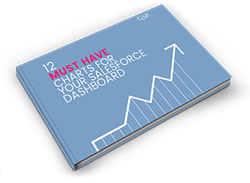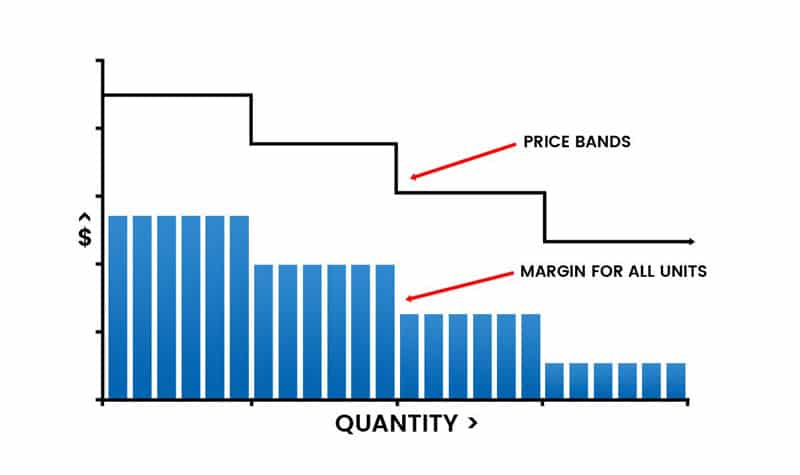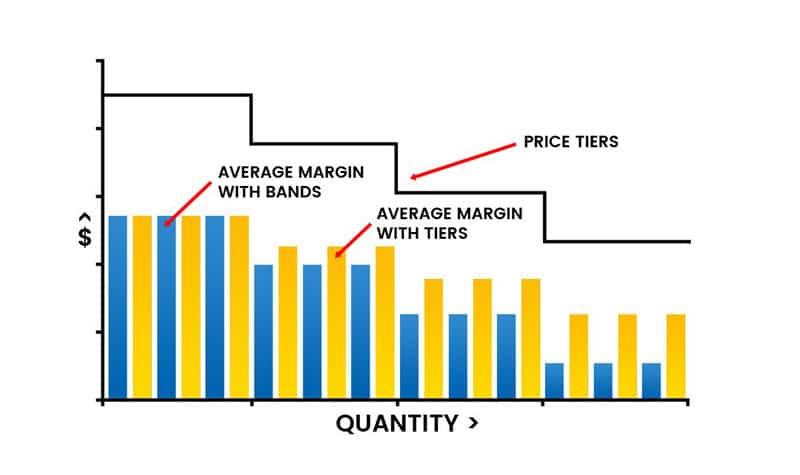Volume Based Pricing in Salesforce: How To Get On The Money
Daniel Tyler creates an opportunity in Salesforce.
Then he opens Excel.
Daniel tinkers around in the pricing spreadsheet for 10 minutes. It happens to be the spreadsheet from three price revisions ago, but never mind.
The spreadsheet gives Daniel the volume based prices for which he’s looking. He types the figures into the Quantity and Sales Price fields in Salesforce and hits enter.
Then Daniel does the same thing for the other products on his opportunity.
Sound familiar?
Or do your salespeople reference a big ring binder file rather than a spreadsheet?
Either way, it’s a common approach to volume based pricing in Salesforce.
And it sucks.
Here’s what’s wrong with it:
- An unnecessary manual effort for salespeople.
- Increased risk of getting volume based pricing wrong.
- Inability to track discounts accurately.
- No guarantee the correct external pricing schedule applies each time.
- Unnecessary difficulty in calculating product margin accurately.
Furthermore, it is impossible to implement the expert advice on controlling discounts that Tony Hodgson, CEO of Pricing Solutions, gave us.
Unfortunately, there’s no standard way to manage volume based pricing in Salesforce.
Sales Price x Quantity = Opportunity Line Item Price. That’s as sophisticated as it gets.
However, we helped Daniel’s company fix that problem.
You can fix it too.
Here are four ways to manage volume based pricing in Salesforce.
Option 1 – Volume-based Pricing by Bands
Here’s what this approach to volume pricing means.The sales price for all units is based on the relevant band for the total quantity.
For example, your pricing table for a product may look like this.
| Product Name: XYZ | Sales Price Per Unit |
| 1 to 10 units | $100 |
| 11 to 30 units | $95 |
| 31 to 100 units | $90 |
| and so on. |
Consequently, if the customer buys 25, the entire purchase’s unit price is $98. Alternatively, if they buy 35, the unit price for units is $95.
In other words, the salesperson bases the price for the entire quantity of the product on the relevant band. Of course, if multiple products are on the opportunity, each one can have a separate set of price bands.
Implement volume based pricing by band in Salesforce
There are two ways to do this.
Using standard Salesforce functionality, create a separate Product record for each band. For example, with the XYZ Product, you will have the following products:
XYZ Product 1 – 10 $100
XYZ Product 11 – 30 $95
XYZ Product 31 – 100 $90
And so on.
This approach is how many companies do volume pricing in Salesforce.
Pro Tip: The band approach to volume-based pricing means an increase in the number of Salesforce products. Consider using the Product Selection Wizard to make it easier for salespeople to select products and add them to opportunities or quotes.
The second option is to use our volume based pricing app. The app removes the need to create multiple products. The salesperson selects the product, enters the quantity, and the volume based pricing app does the work of calculating the correct price.
Advantages of band based volume pricing:
- Easy for the customer to understand.
- Easy for salespeople to understand.
- Straightforward to implement in Salesforce.
Disadvantages of band based volume pricing:
- Lower average unit price and margin on each opportunity compared to other methods.
- Significant increase in the number of products stored in Salesforce.
- Quotes and proposals produced directly from Salesforce include the band within the product name.
However, the main issue with band based volume pricing is this:
The bands encourage customers to purchase higher volumes to benefit from a reduced price. That’s a good thing in terms of the total quantity.
On the other hand, the average unit price reduces across the entire sale. That’s because the lower price applies to ALL units.
Consequently, the margin per unit is lower, and the total margin reduces. That, of course, is not such a good thing.
However, the tiered approach to volume based pricing is a way to overcome these issues.
Option 2 – Volume-based Pricing by Bands
Volume based pricing by tiers is a variation on pricing by bands.The individual tiers may look the same as for bands in the pricing table.
| Product Name: XYZ | Sales Price Per Unit |
| 1 to 10 units | $100 |
| 11 to 30 units | $95 |
| 31 to 100 units | $90 |
| and so on. |
But here’s the critical difference:
With band pricing, the customer pays the same price for all units. In tier pricing, the customer pays the unit price for the first tier, the unit price for the second tier, etc.
In our example, the customer will pay $100 for 1 to 10 units; $95 for units 11 to 30; $90 for units 31 to 100. And so on.
Consequently, the tiers approach to volume based pricing means customers cannot benefit from a lower average price through a small increase in quantity.
As a result, there’s a higher average unit price than band pricing and increased average deal size. It means there’s also a higher total margin on the opportunity.
Here’s how the tier and band approach to volume based pricing compare.
Implement volume based pricing by tier in Salesforce
There is no ‘standard’ way to implement the tiered approach to volume based pricing in Salesforce.
However, our volume based pricing app gives salespeople an automated way to calculate tier-based pricing on opportunities.
Advantages of tier approach to volume based pricing:
- The total price to the customer more accurately reflects the volume purchased.
- It avoids the situation where you are selling more but making less money.
- No need to create multiple versions of the same product in salesforce.
Disadvantages of band based volume pricing:
- It is harder for the prospect to see the price at a glance.
- More problematic for salespeople and marketing communications to give a straightforward product price.
Option 3 – Volume-based Pricing by Increments
Here’s an example of incremental volume based pricing.
| Quantity | Unit Price |
| 1 | $100 |
| 2 | $99 |
| 3 | $98 |
| 4 | $97 |
| 5 | $96 |
| 6 | $95 |
| And so on |
The incremental approach to volume based pricing allows a different shape of the price curve. This method is appropriate for companies that want a more fine-tuned pricing arrangement than tiers.
Customer example of incremental volume based pricing
ILX sells e-learning and face-to-face project management courses and exams. Sometimes they sell to individual members of the public. Small, medium, and large organizations are also customers. These customers extend over five continents.
The company uses incremental pricing to manage this.
As a result, ILX takes a more flexible approach to price. Here’s what the three quantity-based pricing methods look like for ILX.
The incremental approach to volume based pricing allows for a straight line or curve approach to pricing. The curve flattens with higher volume.
ILX goes a step further.
The company has created pricing models for different location. These models reflect the market conditions in each area.
For face-to-face training, ILX also stores the cost of fulfillment on individual price book entries. These vary by location. Therefore, by combining the location-specific pricing model with the fulfillment cost, ILX gets a full and accurate view of all opportunity margins.
An overview of how ILX uses product-based pricing and has innovated with many other Salesforce features is available here.
How to implement incremental volume based pricing in Salesforce
As with tier pricing, there is no ‘standard’ way to implement the incremental approach to volume based pricing in Salesforce.
However, along with bands and tiers, we’ve incorporated incremental pricing in our volume based pricing app.
Advantages of tier approach to volume based pricing:
- Align the pricing strategy more closely with market segments.
- Higher overall margin compared to other pricing options.
- Avoids creating multiple versions of each product.
Disadvantages of band based volume pricing:
- It’s challenging for the prospect to see the price at a glance
- More problematic for salespeople and marketing communications to give a straightforward product price.
Option 4 – Volume-based Pricing by Product Bundles
Product bundles allow customers to buy multiple products in return for a discount or other benefit. As such, it’s a variation of volume based pricing.For example, a bundle may contain five products. The customer is motivated to buy the package under a discount. Perhaps she might otherwise have bought only three or four products.
How to implement product bundles in Salesforce
The Product Bundle Wizard app makes it easy for companies to sell combinations of products in Salesforce.
The app includes a wizard that helps system administrators and product managers create bundles. Salespeople view the bundles in a logical tree structure. This view makes them easy to identify and select.
Advantages of product bundle approach to volume based pricing:
- Encourages customers to make a larger overall purchase.
- Pricing and margins are controlled within the bundle.
- Easy for the customer to understand the overall bundle package and price.
Disadvantages of band based volume pricing:
- Customers may constrain their overall purchase to take advantage of a bundle price (perhaps our customer might have bought six products if the bundle wasn’t available?).
Which volume based pricing approach to use?
Look at the average volume per order for each of your products.The higher the average quantity, the more the difference in volume between the bands tends to grow. Companies often have narrow bands at low volume and larger bands at high volume. This means the larger the average order, the more you will be giving away in margins.
However, the band approach to volume based pricing is appropriate when:
- Volumes are relatively low, and bands are narrow.
- The price implied by the band is only a guide. There is price negotiation between the salesperson and the customer before the order is place.
Conversely, as volumes rise, consider the tiered approach to quantity based pricing. It’s appropriate when:
- You need to manage margins carefully than the band approach allows.
- The visible tiers motivate customers to buy increased volume.
The incremental approach provides a granular solution to volume based pricing. Use this when:
- Tight control over margins is required.
- Clear visibility of the benefits of increased purchasing volume is of less importance. After all, using the incremental approach makes it harder to communicate the benefits of volume based pricing visible on your web site or other corporate literature
Remember, you do not need to use the same approach for every product in your portfolio. Combine the methods within the same product portfolio.
For example, the band approach may be appropriate with some products, the tiered approach with others, and incremental volume based pricing with yet more.
And of course, if it makes sense in your business to bundle products together, then do so.
Daniel’s approach to volume based pricing
Here’s what Daniel’s company did.In Salesforce, we implemented the tier solution to volume based pricing for most of their products using our app. It’s streamlined the process for Daniel and his colleagues. No more spreadsheets!
For some low volume, less commonly sold products, we implemented the band approach. For these products, there is a lengthy and highly interactive sales process. As such, the prices per band are only a guide to the sales team during this process.
The company did two other things.
They implemented the Product Selection Wizard. The wizard makes it much easier than the standard layout in salesforce to add products to opportunities. They also implemented the Bundle Selection Wizard. This makes it easy to create and promote logical groupings of products that benefit the customer.
The result?
More accurate sales forecasts because each opportunity accurately reflects the products the customer is considering buying. User adoption of Salesforce is up. Salespeople work more efficiently. And there is far greater control over pricing and discounts offered to customers.
Besides, there’s one more result: a 4% increase in average margin per opportunity.
And that, I think you’ll agree, is well worth going after.
Further reading
- The Power of Pricing. Published in 2003 by McKinsey, but still a great article on the impact (negative and positive) of volume-based pricing.
- 10 Expert Tips To Improve Discount Control. Advice and recommendations from pricing expert Tony Hodgson.
- The Essential Guide to Product Price Books in Salesforce. Explanation of this critical feature that supports pricing in Salesforce.
- GSP Salesforce apps. Videos and descriptions of the Volume Pricing App, Product Bundle Wizard, Product Selection Wizard, and more.
Superb Pipeline Visibility and Sales
Performance Metrics from this free Dashboard.
Volume Pricing App Video
Here’s the Volume Based Pricing app in action. Get in touch today for a free trial.

Don’t have time to read the entire Blog Post right now?
No problem.
You can download the entire “Your Sales Forecast Is Probably Wrong” eBook for free by completing the form below!







